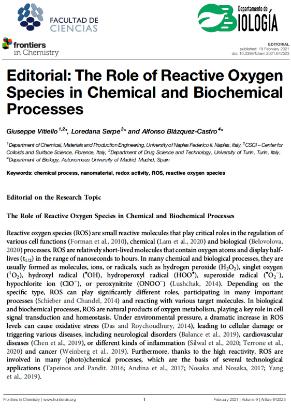Giuseppe Vitiello, Loredana Serpe y Alfonso Blázquez-Castro

Reactive oxygen species (ROS) are small reactive molecules that play critical roles in the regulation of various cell functions (Forman et al., 2010), chemical (Lam et al., 2020) and biological (Belovolova, 2020) processes. ROS are relatively short-lived molecules that contain oxygen atoms and display half-lives (t1/2) in the range of nanoseconds to hours. In many chemical and biological processes, they are usually formed as molecules, ions, or radicals, such as hydrogen peroxide (H2O2), singlet oxygen (1O2), hydroxyl radical (•OH), hydroperoxyl radical (HOO•), superoxide radical (•O2−), hypochlorite ion (ClO−), or peroxynitrite (ONOO−) (Lushchak, 2014). Depending on the specific type, ROS can play significantly different roles, participating in many important processes (Schieber and Chandel, 2014) and reacting with various target molecules. In biological and biochemical processes, ROS are natural products of oxygen metabolism, playing a key role in cell signal transduction and homeostasis. Under environmental pressure, a dramatic increase in ROS levels can cause oxidative stress (Das and Roychoudhury, 2014), leading to cellular damage or triggering various diseases, including neurological disorders (Balance et al., 2019), cardiovascular diseases (Chen et al., 2019), or different kinds of inflammation (Silwal et al., 2020; Terrone et al., 2020) and cancer (Weinberg et al., 2019). Furthermore, thanks to the high reactivity, ROS are involved in many (photo)chemical processes, which are the basis of several technological applications (Tapeinos and Pandit. 2016; Andina et al., 2017; Nosaka and Nosaka, 2017; Yang et al., 2019).
Universidad Autónoma de Madrid © 2008 · Ciudad Universitaria de Cantoblanco · 28049 Madrid · Información y Conserjería: 91 497 43 31 E-mail: informacion.ciencias@uam.es Gestión de estudiantes de Grado y Posgrado: 91 497 8264 / 4329 / 4353 / 4349 / 6879 / 8362 E-mail: administracion.ciencias@uam.es